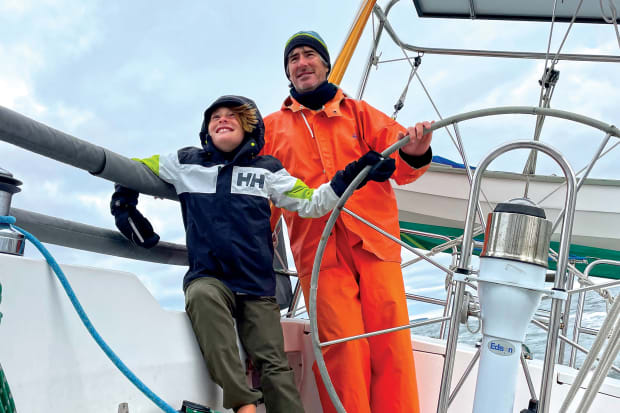
Photo courtesy Karen Fallon
Dousing a big headsail like an asymmetrical spinnaker takes careful crew coordination, and on the J/32 Betsy, that teamwork is a family affair. Nine-year-old Jamie Fallon opens the forward cabin hatch and stands by to collect the sail; his 11-year-old brother, Ben, steers dead downwind being careful not to jibe; mom Karen releases the halyard, sheet, and tackline; while dad and husband Tim is forward managing the douse and guiding the sail to Jamie.
“It’s pretty sweet when we all work together like that,” Karen says.
It’s also a great example of how cruising full-time as a family has helped them gel as a team—a goal that sometimes eludes even the most experienced of sailors. Sailing takes a wide array of forms on everything from dinghies to superyachts, but once the lines are slipped, each crew has to meld into a team to safely and happily complete the cruise, passage, or race.
So, what are the most important elements of sailing teamwork, and are they dependent on your preferred discipline or current life phase? For insight, I interviewed three very different teams: the Fallons, a family of four who live on a boat year-round; two professional sailors who raced a 33-footer nonstop for two weeks; and a retired couple who spent seven years circumnavigating on a Valiant 42. They all have given the concept of teamwork quite a bit of thought, and while their details vary, their stories share three common threads: the unifying focus of a common goal, the differences between family and team, and the circular relationship between honesty and trust.
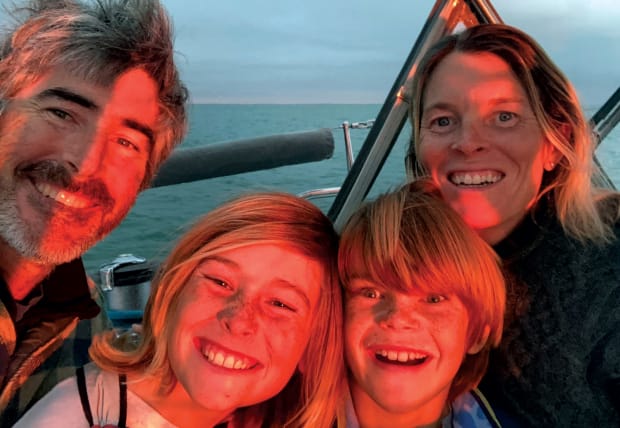
Photo courtesy Karen Fallon
Team Fallon, the Family
Karen and Tim Fallon and their two boys, Benjamin and Jamie, are currently enjoying their second school year in a row on their J/32. After a rather hurried round trip from New England to the Bahamas and back again over the winter of 2021-22, they left Massachusetts a month earlier for their second voyage south. The Bahamas were the ultimate destination, but they stopped along the way to visit family and friends and to take in some homeschool-related adventures. They also added a few carefully timed overnight passages.
Their boys are an ideal age, Karen says: “They can swim, so they’re relatively safe. And they still want to hang out with us.”
The Fallon parents were serious teammates long before they became a couple. As team racers, they won the ISAF Team Racing World Championships in 2003 and 2005. “We gelled very well,” Karen says. “When you sail with someone for a long time, you don’t really have to talk.” They eventually started dating and married in 2010; both their boys started sailing before they were a month old, and the family summers on a 26-foot catboat.
Their onboard teamwork now includes living aboard and homeschooling their boys. Both parents share the teaching load, though Tim (an engineer) takes on more of the math while Karen (a psychologist) handles English language arts. “We do school in the morning,” Karen says. “And that’s our carrot; we go play in the afternoon. The kids are really good about getting their work done.” They also supplement their own efforts with some online tutoring. The first year “taught me to be a little more patient, and we are getting better at it. So it is getting easier.”
Living on a boat with a family of four is all-consuming, so Karen and Tim share the chores. She’s in charge of “all things food related,” while Tim takes care of boat maintenance and is the primary navigator. On overnight passages, each parent takes a three-hour watch. Though they don’t yet stand night watches, the boys have their own jobs.
“They are responsible for putting their bedding away, checking the bilge for water, putting the flag up at 8 a.m. and down at sunset,” Karen says. “Our oldest is now in charge of giving the family a weather briefing that he researches online. They also take turns on the helm for short periods.”
Karen says the foundations of teamwork are trust and shared common goals. Last year, while discussing a family “mission statement,” they talked about why living on the boat was so important to each of them. “Being closer as a family was way up there,” Karen says. “In normal life, [the kids are] gone eight hours a day. We didn’t want to do that.”
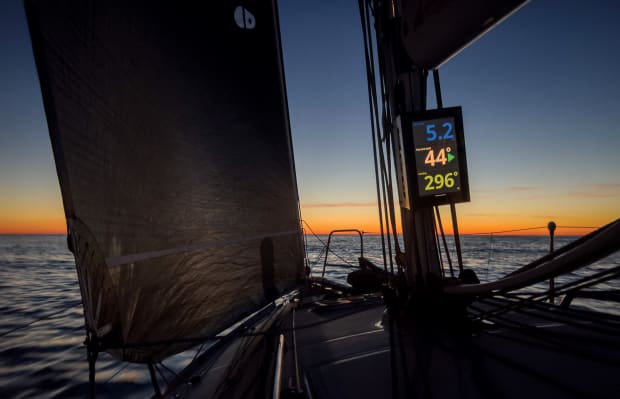
Photo by Tim Butt/Vertigo-films.com
The Professionals: It Takes Two
Shirley Robertson OBE and Dee Caffari MBE are household names in sailing (and both have received honors from the British Crown for their accomplishments), but their equally impressive CVs were built on “separate planets” of the sailing galaxy—dinghy and keelboat racing versus solo circumnavigating. Shirley was the first British woman to win consecutive gold Olympic medals, first in a singlehanded dinghy and then in a three-person keelboat. Dee has sailed around the world six times, and she was the first woman to sail solo and nonstop around the globe in both directions.
Perhaps it’s not surprising that when they first teamed up last year for a summer of doublehanded distance racing, these two independent women struggled to gel into a sailing pair. Their experience learning how to get the best out of each other provides a unique perspective into what it takes to develop a strong team.
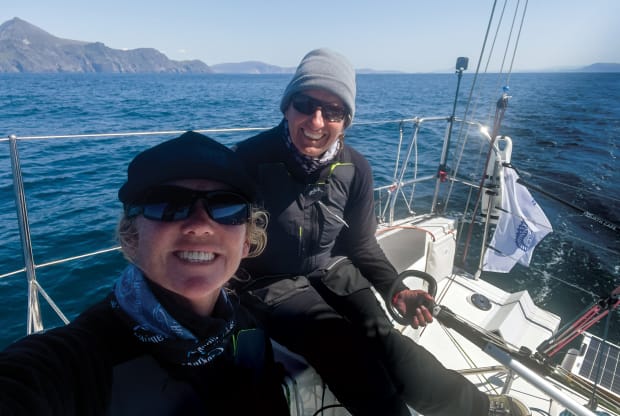
When they first chatted about sailing together, Shirley had already fallen in love with the fresh challenge of two-handed keelboat racing—partly because the monthly races from her home port of Cowes attract very competitive double-digit fleets. “It’s a bit mad,” Shirley says, with a quiet chuckle. “Pretty intense, with just two people. And initially without the level of support that I was used to.”
Their original schedule was four races ranging from 50 to 120 miles, which meant that on their Sunfast 3300 they would usually finish at what Dee calls “stupid o’clock in the morning.” She was the one who suggested a much longer race as their season finale: August’s 1,800-mile Sevenstar Round Britain and Ireland Race.
“I didn’t want to just float around in the English Channel,” Dee says. “So I planted the seed over a cup of coffee. Amazingly, and rather naively actually, Shirley was like, ‘Yeah, all right.’ I think she regretted that several times along the way!”
The two pros quickly put together a plan, and Dee came to Cowes to help with boat prep. Right away, they found a fundamental difference in their approaches.
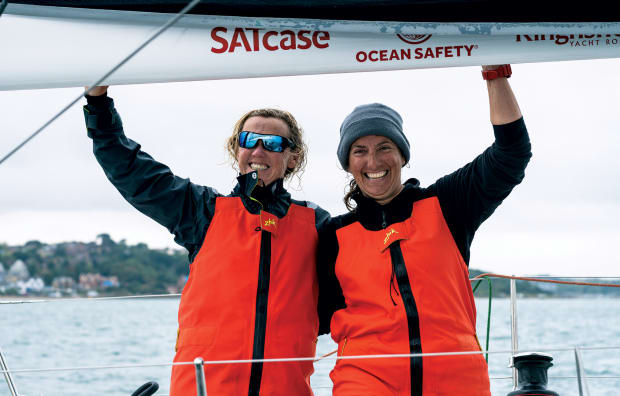
Photo by Tim Butt/Vertigo-films.com
“Shirley is no stone left unturned, list after list after list of jobs.” Dee says. “Where I come from, the boat’s never going to be ready. So, let’s just get on with it—big-picture thinking.”
She was also a little intimidated; Dee remembers telling Shirley, “I feel you’re a bit scary,” which made her teammate laugh. “We both had each other in these little bubbles,” Dee says, “and we had to burst them and get to know the real people who were involved.”
Their first finish as a team was a close second to another Sunfast 3300, but Shirley admits they made several errors, which led to a real tension onboard. “I love things to be talked through in advance, so that decisions evolve…and the harder it got, the quieter Dee got.”
Just like the boat prep, they each approached the actual sailing quite differently.
“I brought an intensity, a certain detail to it; I wanted to hit the start line and know that we were going to be quicker than everyone else,” Shirley says. Dee’s focus was, again, bigger picture: “She was just much more about the sailing. After the race, I thought, we’re not going to be able to make this work, just the two of us; we need help.”
“It was very apparent to us really early on that we came from completely different ends of the spectrum,” Dee says, agreeing that she tends to internalize her own decision-making. “As it gets more complex, Shirley communicates more; it’s like everything in her head comes out verbally.” So, when Shirley would suggest another new task, Dee says her knee-jerk response was a bit sarcastic: “ ‘Oh right, and what else do you want me to do?’ The two of us were sailing like two independent people, which was quite funny.”
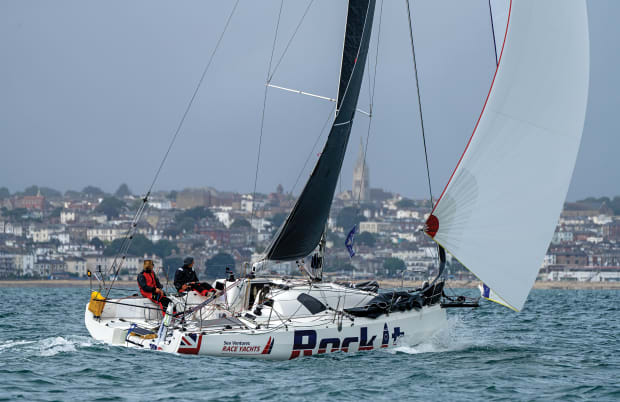
Photo by Tim Butt/Vertigo-films.com
In their debrief after that first race, they identified this communication gap as a huge problem. “So we got on it,” Dee says matter-of-factly. “We both said, let’s have someone external come and sail with us to get us over these hurdles.”
Nigel King, a coach who was already familiar with both women and their sailing specialties, joined some of their practice sessions and enabled more effective communication. As Shirley puts it, he “helped us understand each other.”
He also brought some humor onboard. “Nigel was just laughing,” Dee says. “He found it hilarious, seeing us working together.” But she agrees that he quickly identified the solution. “I had to learn to talk more, and Shirley had to learn to listen. And we both had to learn what each other needed. It was fascinating, actually, doing the psychology behind us both to get out of the boat what we wanted to achieve.”
By the start of the Round Britain and Ireland Race in August, Dee says, “we could read each other a lot better.” Though their results would be a disappointment, the 14 days battling calms, headwinds, bone-chillingly damp cold, and extreme fatigue solidified a special bond that’s outlasted the racing season.
“We’ve actually ended up with a new friendship,” Dee says. And they feel like they’ve just scratched the surface of their team’s potential.
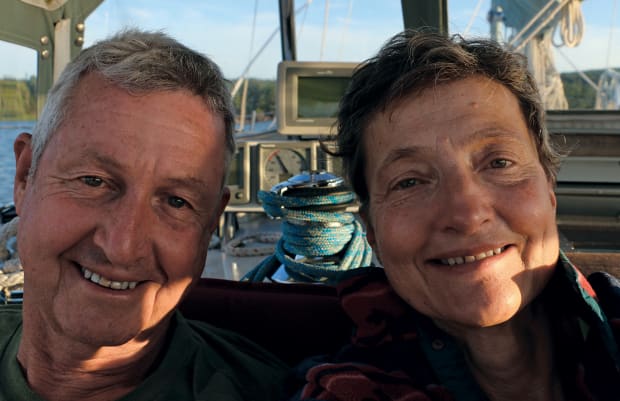
Photo by Zdenka Griswold
Round-the-World Couple
When Jack and Zdenka Griswold married in 1989, they were both working in New York City—and Zdenka had never been on a boat. Jack grew up sailing small boats, and seeing how much he enjoyed weekend outings with friends inspired Zdenka to take lessons. She thrived on the challenges of engineless boating, so the couple bought a 26-footer.
“Jack at the time was a crazy daredevil,” she says, laughing. “He just kept telling me all this stuff was normal! I remember one time, crossing Long Island Sound in the middle of a squall, and I had foulies on.” Jack didn’t have wet-weather gear (though neither can remember why), so he hunkered down in the cabin while Zdenka sailed on. “I’m at the helm, with lightning and thunder coming down all around us, asking, ‘Should we be sailing in this? A lightning bolt just landed right next to us.’ And he’s saying, ‘Yeah, it’s all fine.’ ”

Photo by Zdenka Griswold
Jack points out that all those scary moments could’ve turned her off to sailing, but Zdenka says she’s glad she had “an adventurous beginning”—and took sailing lessons on her own. When they decided to quit their jobs and go cruising full-time on their Valiant 42, Kite, their trust in each other enabled a conscious decision: They would sail doublehanded.
“We’ve never had crews; it’s just always been the two of us,” Zdenka says. “And that’s worked well for us.”
They did have to gradually increase their expectations of one another.
“When we first started doing overnight passages,” Jack says, “we would be very solicitous of each other; if Zdenka was fast asleep [at watch change], I would let her sleep another half hour. That didn’t last for too long,” because “you have to step up and do your job: to sail the boat and keep yourself healthy and safe on the boat.”
They both agree that when passagemaking offshore, they become more of a team than a couple; the more complex interactions of life on land become more straightforward at sea and demand a different kind of collaboration.
“What one of our friends calls the ‘pink’ jobs and the ‘blue’ jobs merge into one,” Zdenka says. “You’re alone on watch, handling exactly the same thing that your spouse is handling. You have no choice but to work together, and it just sort of comes naturally.”
In a 2018 article for SAIL, the couple spelled this out even more clearly while also alluding to the unique pleasures and necessity of time alone. “We were a good team running the boat, each of us with our own set of responsibilities, but also stepping in for each other as needed. Perhaps passagemaking was our escape valve, because that was one time we didn’t really see much of each other.”
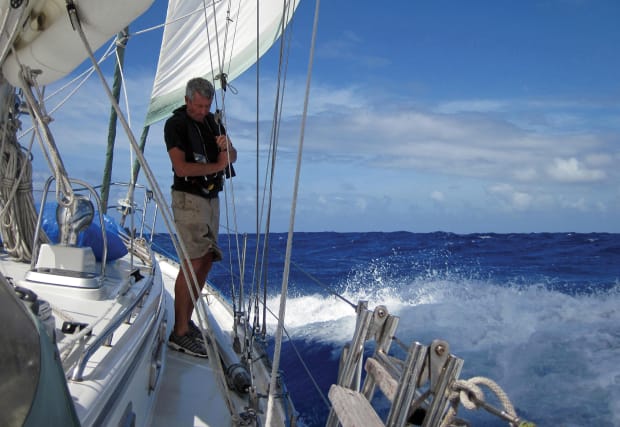
Photo by Zdenka Griswold
In the Same Boat
Whether raising kids, adding to one’s racing résumé, or heading offshore for a retirement cruise, all of these sailors agree that it’s critical to be on the same page as your sailing teammate in terms of goals and expectations.
“Sometimes we saw couples where one person wasn’t ready to leave on a passage,” Zdenka says. “That can lead to bad consequences—and not a very pleasurable journey.”
Tim and Karen Fallon were successful teammates long before they became a family, and now their common goal is raising independent thinkers. “On the boat we feel closer; more in tune with our kids’ needs,” Karen says. “People might think it’s weird, but I think we’re teaching them that it’s OK to not conform; that you don’t have to do something just because everyone else is doing it.”
Dee Caffari says open communication is the key to a strong team.
“You need to be prepared to have the difficult conversations,” she says. And, as you might expect by now, Shirley Robertson homes right in on the specifics: You need “a willingness to put your hand up and say, I can’t do that, even when things aren’t going well.”
Along with the sailing, finding a way to work together was what she enjoyed the most about her season with Dee. “I’m really quite proud of that, that we found a way to do it. Time with people from different planets is pretty special, as a life experience. Though it is also quite. . .out there.”
Carol Newman Cronin is an award-winning author, editor, and 2004 Olympian; her Thursday blog, Where Books Meet Boats, attracts a wide range of readers.
April 2023








